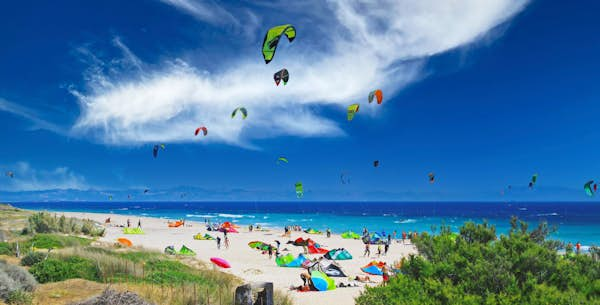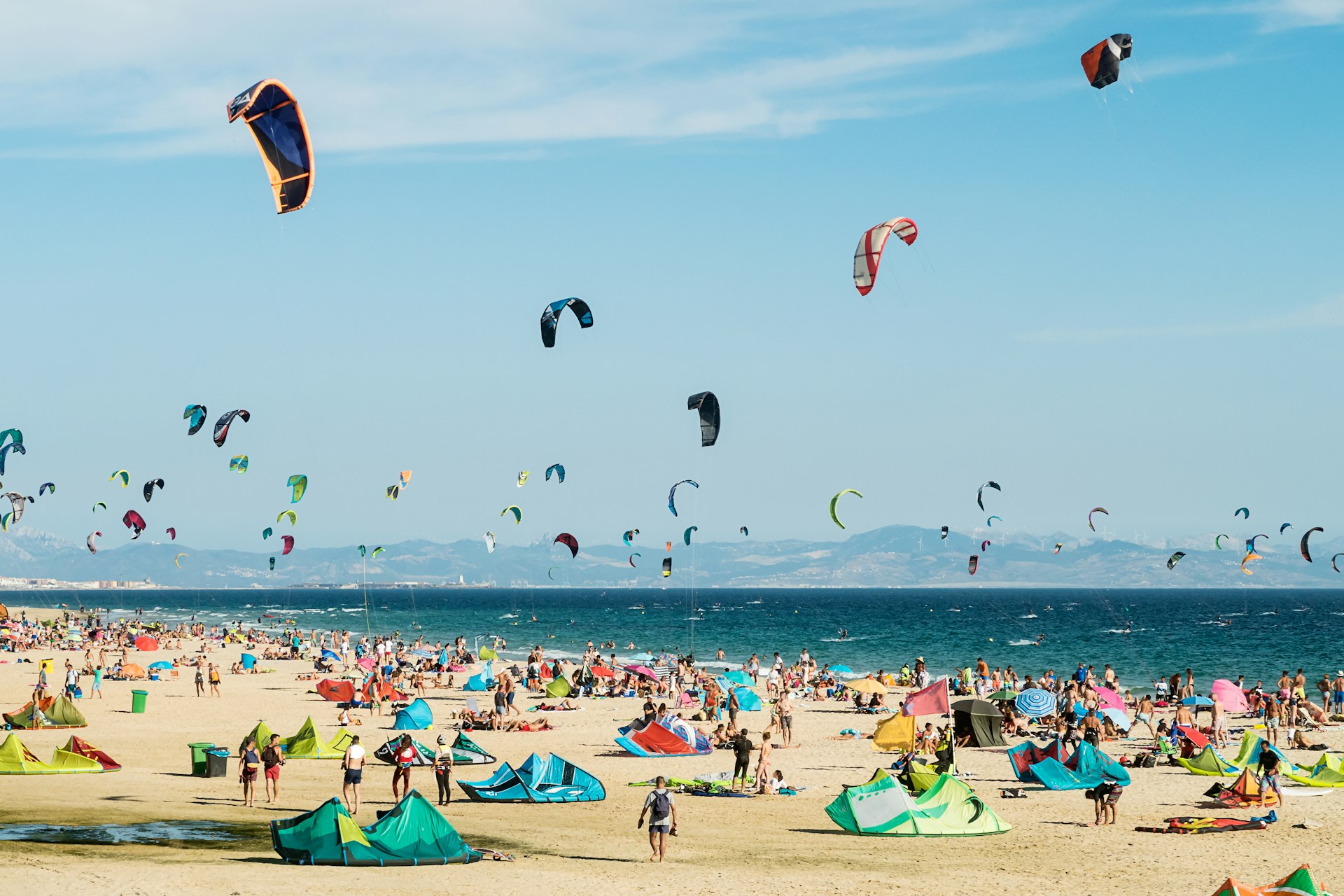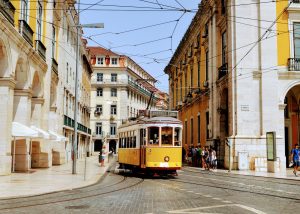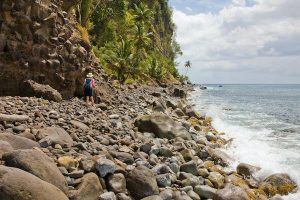
Our new series features under-the-radar holiday destinations that are often overlooked by visitors but cherished by locals. Here, we ask four experts on Spain for their top picks.
Spain offers an embarrassment of riches, which understandably draw tens of millions of visitors each year. So that’s why we asked some of our expert Spain-based correspondents for the places they like to visit, special destinations that are a bit off the well-beaten track.
Explore the world in comfort with the latest travel insight from our weekly newsletter delivered to your inbox.  Tarifa is one of the best places to practice kitesurfing © Shutterstock / Juanamari Gonzalez
Tarifa is one of the best places to practice kitesurfing © Shutterstock / Juanamari Gonzalez
A surfing hub at Spain’s southern tip: Tarifa
Isabella Noble grew up in Málaga and now splits her time between Andalucía and Barcelona
My family stumbled across laid-back, surf-loving Tarifa in the 1990s, and I still escape here every year, whether for a few beachy days in early September (bliss) or working remotely during low season. On the southernmost tip of mainland Europe, in Cádiz province, Tarifa is one of Andalucía’s most magical coastal towns, with miles of wild golden-white beaches, a relaxed vibe and views of neighboring Morocco across the Strait of Gibraltar.
Cádiz’s Atlantic-washed Costa de la Luz has been popular with Spaniards for years, and Tarifa has a special edge thanks to its lively kitesurfing and windsurfing scene. The entire undeveloped coast stretching northwest from Tarifa is a protected parque natural, and even when things get busy in summer, there are plenty of hidden corners. I love the coastal walk past natural sea pools from tiny Bolonia’s Roman ruins to Punta Paloma dune. Or the hike to secluded El Cañuelo beach – a pine-fringed, back-to-nature paradise where there’s often no one else around.
I usually stay at one of the small, independent boutique hotels in Tarifa’s meandering old town; The Riad is a stylishly converted 17th-century home with creative Moroccan-Andalucian design, while Hostal África has boho-cool rooms and rooftop yoga. You’re spoiled for choice with Tarifa’s lively international-influenced food scene; I often grab a fruit-and-yogurt breakfast bowl at Morocco-inspired Café Azul, and later stop for tapas (just-cooked tortilla, payoyo goat’s cheese) on the terrace at El Lola, which also serves local sherries and Cádiz wines.
 Vineyards dot the hillsides between such villages as Porrera in the rural Catalan region Priorat © Getty Images
Vineyards dot the hillsides between such villages as Porrera in the rural Catalan region Priorat © Getty Images
Superb wines in Catalan villages: Priorat
Joan Torres is from Barcelona
In the heart of rural Catalonia, Priorat is an off-the-beaten-track region where visitors can learn about traditional wine making. Many consider the wines produced in Priorat to be the most sophisticated in all of Spain (with prices to match).
Dotted with several medieval villages, Priorat is best visited on your own wheels, road-tripping from village to village, and cellar to cellar. Álvaro Palacios and Mas Doix are some of the most popular – yet you shouldn’t miss lesser-known, smaller-batch wineries such as Hericamps, which produces no more than 5000 bottles a year.
Porrera, Gratallops, Siurana and Falset are all beautiful villages packed with cellars, where you can also find accommodations fitting for every wallet, ranging from budget hostals to luxury boutique hotels within the wineries.
When it comes to food, La Cooperativa de Porrera is one of the best restaurants in the region for authentic Catalan food, while Brichs, located in Falset, is the place to satisfy more demanding gourmets looking for a more modern version of the local cuisine.
 At Cala d’Hort beach in Ibiza, swimmers can admire mysterious Es Vedrà island © Eo naya / Shutterstock
At Cala d’Hort beach in Ibiza, swimmers can admire mysterious Es Vedrà island © Eo naya / Shutterstock
The lower-key side of Ibiza: Sant Josep de sa Talaia
Natalia Diaz lives in Madrid
Ibiza is well known as the unrivaled party capital of Europe – yet this is just a tiny sliver of the story of this Mediterranean paradise. Beyond the strobe lights and glamorous nightclubs, the Balearic island has a serene side that’s perfect for those who prefer a more laid-back and nature-oriented experience. Drive around to explore Ibiza’s breathtaking natural beauty, from its numerous calas (coves) and majestic cliffs, to its white sand coastlines embraced by clear sapphire waters. Sa Caleta (Es Bol Nou) beach hosts the ancient ruins of the first Phoenician settlement in Ibiza, a Unesco World Heritage Site atop a cliff with panoramic views of the Balearic Sea.
When I go to Ibiza, I prefer staying at a short-term rental in Sant Josep de sa Talaia, on the western side of the island. (If you’re a big group, you can even rent out an entire villa). Sant Josep offers a perfect mix of rugged natural beauty, chill-out bars and quiet coves, including Cala Comte, Cala d’Hort and Port des Torrent. Es Boldado on Cala d’Hort is hands down my favorite restaurant on the entire island – I can stay here all day dining on fresh seafood and traditional ibicenco cuisine and sipping premium Spanish wines, while enjoying its main feature: a spectacular view of mythical Es Vedrà island, believed to be the tip of Atlantis and legendary home to sirens, sea nymphs and even UFOs.
 A hiker’s paradise, Parque Natural de Somiedo in Asturias abounds with natural beauty © Carmen Martínez Torrón / Getty Images
A hiker’s paradise, Parque Natural de Somiedo in Asturias abounds with natural beauty © Carmen Martínez Torrón / Getty Images
Heat-beating hikes in the mountains of Asturias: Somiedo
Paula Sánchez Iglesias and Daniel Del Río Espina are from Avilés and run the Spanish travel blog, Hacemoslasmaletas
In the lush valleys, lakes, and mountains of Asturias in northern Spain, lies Parque Natural de Somiedo, a Unesco Biosphere Reserve offering a refreshing escape from the summer heat. Situated in the Cantabrian Mountains, Somiedo is a hiker’s paradise that offers breathtaking views of glacial lakes, limestone peaks and beech forests. You’ll also see brañas, traditional cattle-herding settlements with clusters of tietos (thatched cottages). Two of the best hiking routes in the area are El Valle del Lago and Los Lagos de Saliencia.
This rural paradise is also the habitat of the largest group of brown bears in Western Europe, with around 280 individuals freely roaming the western half of the range. Bear watching is a popular activity here – though we recommend doing this with a local guide so you can learn about conservation efforts. Wolves, wildcats, chamois and red deer can also be found here, along with the possibility of spotting griffon vultures, golden eagles or capercaillies (colorful fowl).
Stay in the village of Pola de Somiedo, where you’ll find a range of hotels, homestays and B&Bs. Come meal time, you should book a table at the family-run El D’Iban in the nearby village of Braña de la Peral. Another great dining option, particularly during the colder months, is Sidreria Carion, where you can savor the region’s famous cider, along with hearty dishes like Asturian fabada (a bean stew) or cachopo, a filling dish featuring two large veal or beef escalopes filled with ham and cheese, coated in breadcrumbs and served with locally sourced ingredients. Delicious.



